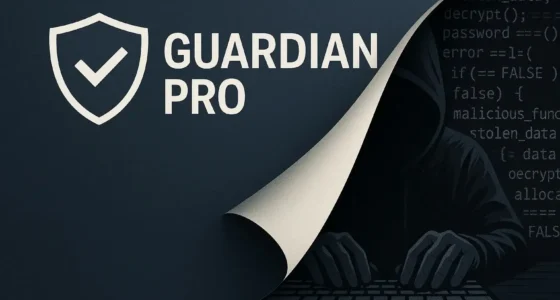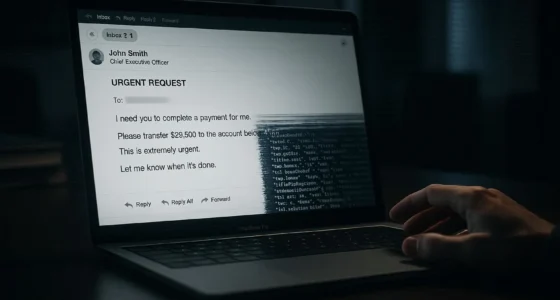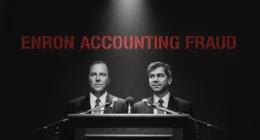The hurricane’s winds barely stopped howling. Then the calls started coming.
Sarah Martinez answered her phone three days after Hurricane Helena destroyed her coastal Florida town. The voice sounded urgent, compassionate even. They claimed to represent the Red Cross. Her neighbors needed help. Could she donate $500 to provide emergency shelter?
She gave her credit card number immediately. After all, her own home survived. Others weren’t so lucky.
That $500 vanished into darkness. Moreover, the thieves sold her card information. Within two weeks, fraudsters charged $3,847 to her accounts. The real Red Cross never received a penny.
Sarah’s story isn’t unique. In fact, fake charity scams explode after every disaster. These predators don’t wait for communities to heal. They strike while the wounds bleed fresh.
The Hunger That Never Sleeps
Disaster strikes. The nation mourns. Meanwhile, criminals sharpen their knives.
The Federal Trade Commission reported Americans lost over $500 million to fake charity scams between 2020 and 2023. However, experts believe the real number climbs much higher. Most victims never report their losses. Shame keeps them silent.
These aren’t random crimes. Consequently, they follow a pattern as predictable as the disasters themselves.
Within hours of any major catastrophe, fake charity websites materialize online. Phone banks activate in foreign countries. Scammers create social media pages mimicking legitimate organizations. They copy logos perfectly. Their websites look professional, polished even.
But behind the masks, monsters wait.
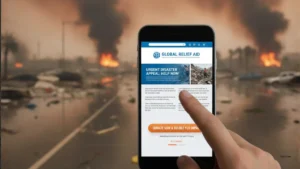
How They Hunt You Down
Fake charity scams operate like military campaigns. First, criminals monitor news feeds constantly. When disaster hits, they deploy immediately.
Their weapons come in many forms:
- Phone calls from “representatives” using spoofed caller IDs
- Emails with urgent subject lines and heartbreaking photos
- Social media ads targeting specific geographic regions
- Text messages claiming immediate action saves lives
- Door-to-door solicitors with fake identification badges
- QR codes posted in public places are leading to fraudulent donation sites
The tactics evolve constantly. Therefore, yesterday’s warning signs become tomorrow’s trusted approaches.
James Chen, 67, learned this truth the hard way. After wildfires consumed his California community, a man knocked on his door. He wore an official-looking vest. His clipboard held photos of burned homes. His tablet accepted donations on the spot.
James donated $1,200 for “emergency pet rescue operations.” The receipt looked legitimate. The thank-you email arrived within minutes.
Three months later, investigators told James the truth. No pet rescue organization existed. Furthermore, the same scammer hit 47 other residents in his neighborhood. Total losses exceeded $89,000.
The man was never caught.
The Anatomy of Deception
These predators understand human psychology. Specifically, they exploit our best impulses during our worst moments.
Disasters trigger powerful emotions. Fear grips survivors. Guilt haunts those who escaped harm. Compassion drives people to help immediately. Scammers weaponize these feelings.
They create urgency. “Donate now or children go hungry tonight.” They manufacture scarcity. “This matching grant expires in one hour.” They fabricate authority. “We’re working directly with FEMA.”
Every word carries calculated deception.
Real charities follow strict regulations. They register with state authorities. Their finances undergo public scrutiny. Legitimate organizations never pressure donors. Instead, they welcome questions and provide detailed information.
Fake charities do the opposite. They demand immediate payment. Cash only, gift cards preferred. Wire transfers work too. Anything that can’t be traced or reversed.
Once your money vanishes into their accounts, it never returns.
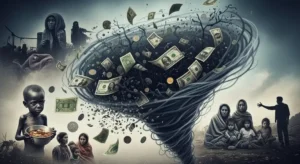
The Ghosts They Leave Behind
The financial loss cuts deep. However, the emotional damage runs deeper.
Victims describe feeling violated twice. First, by the disaster itself. Then by those who promised to help heal it.
Sarah Martinez still answers her phone with dread. Moreover, she questions every charitable appeal now. The generosity that once defined her personality transformed into permanent suspicion. She donated to hurricane relief. Instead, she funded someone’s vacation.
The Federal Trade Commission reports that fake charity scams targeting disaster relief increased 48% between 2021 and 2023. Each percentage point represents thousands of victims. Behind every statistic, a Sarah or James exists. Their trust shattered. Their savings stolen.
Real disaster victims suffer most. Legitimate charities report donation declines after high-profile fraud cases. People grow suspicious of all appeals. Consequently, actual relief efforts receive less funding. Children go hungry. Families stay homeless longer. Medical care gets delayed.
The predators destroy twice. They steal from generous donors. Then they steal from desperate victims who need that money to survive.
Recognizing the Predator’s Mark
Fake charity scams leave tracks. You just need to know where to look.
Warning signs appear consistently:
- High-pressure tactics demanding immediate donations
- Requests for payment via gift cards, wire transfers, or cryptocurrency
- Vague descriptions of how donations will be used
- Thank-you emails from free email services instead of organizational domains
- No physical address or phone number listed
- Charity names closely resembling legitimate organizations
- Unsolicited contact immediately after disasters
- Resistance to providing tax-exempt numbers or registration information
The Better Business Bureau maintains a database of verified charities. The IRS publishes a list of tax-exempt organizations. State attorneys general track registered charities.
Check these sources before donating. Real charities expect scrutiny. Fake ones evaporate under examination.

Protecting Yourself From the Pack
You can defeat these predators. Nevertheless, you must stay vigilant.
Never donate immediately after unsolicited contact. Instead, research the organization independently. Search for the charity’s name plus “scam” or “complaint.” Visit their official website directly rather than clicking links.
Verify the charity’s registration. Call them using a number you find independently, not one they provide. Ask specific questions about their programs and finances.
Use credit cards for donations. They offer fraud protection and dispute resolution. Avoid cash, gift cards, and wire transfers completely. These payment methods protect scammers, not donors.
Document everything. Save receipts, emails, and correspondence. Legitimate charities provide detailed documentation. Scammers send vague confirmations or nothing at all.
If something feels wrong, trust your instincts. Furthermore, report suspicious appeals to the FTC, your state attorney general, and the Better Business Bureau.
The Shadow That Never Fades
The next disaster is coming. Hurricanes will strike. Earthquakes will shatter cities. Wildfires will rage.
And the predators are already waiting.
They sit at computers in darkened rooms. Their phones charged. Their fake websites ready to activate. When tragedy strikes, they strike faster.
Fake charity scams represent more than financial crimes. They corrupt human kindness itself. Every dollar stolen from a donor is a dollar that never reaches someone in desperate need.
Sarah Martinez still wants to help disaster victims. However, she freezes every time donation appeals arrive. The predators didn’t just steal her money. They stole her ability to help others without fear.
That might be their cruelest theft of all.
The monsters are out there. They’re patient, organized, and utterly ruthless. Next time disaster strikes, they’ll be calling. Knocking on doors. Sending emails that break your heart.
But now you know their faces. You’ve learned their tactics. You understand how they hunt.
Don’t let them make you their next victim. And don’t let them steal from the people who truly need help.
Because when real disaster victims go without aid, the predators win twice.
Resources
[1] Federal Trade Commission. “Avoid scammers trying to profit from a deadly tornado.
[2] Federal Trade Commission. “Consumer Sentinel Network Data Book 2024.”
[4] Internal Revenue Service. “Tax Exempt Organization Search.” Updated Monthly.
[5] Better Business Bureau. “BBB Wise Giving Alliance Charity Verification.” Updated Continuously.
Related reading(suggested)
[1]Email Phishing Evolution: Most Dangerous Email from Hell
[2]Fake Antivirus Software: How Scareware Bleeds You Dry
[3]Tech Support Scams: Microsoft/Apple Impersonators Exposed


